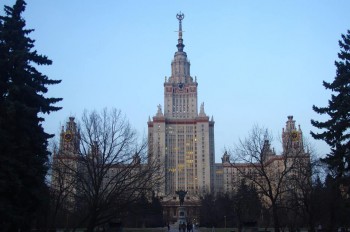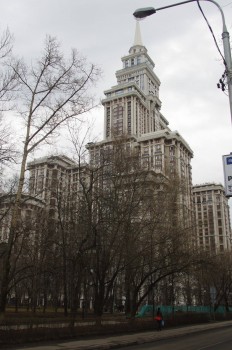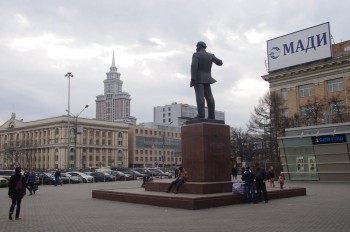The above photograph is of the main building of Moscow State University in the Sparrow Hills district of Moscow. This is one of the so called Seven Sisters – the Stalinist buildings that are prominent in the Moscow skyline. When completed in 1953 this was the tallest building in the world outside New York City, and it remained the tallest building in Europe until 1990. The building was built partly with gulag labour. As it was nearing completion, the gulag workers were housed inside it in order to minimise the number of guards required, so the building functioned as something resembling a gulag itself during construction.
The Seven Sisters were built in the 1950s after the USSR obtained the technical knowledge to built large steel framed skyscrapers from the United States. There are a few more such buildings scattered throughout the former USSR and the former Warsaw Pact states. The most notable of them outside Moscow is the Palace of Science and Culture in Warsaw, which I have written about before.
The Polish attitude to that building is, at this point in time, mixed. It is a memento of having been occupied by the Soviets, an experience of which the Poles are not especially fond of the memory of. However, the familiar becomes familiar, and it is hard to imagine it not being there. The Palace of Science and Culture is full of many good cinemas, theatres, concert halls, and other venues for cultural activities, and many a good evening has been had there by many a Polish person. As the years go by, other tall buildings have been built in Warsaw, none of which have anything like the same style, and the Palace of Science and Culture has become just a historical artifact (and a reasonably interesting one) in a more modern, and more western city. Nobody would ever think of building another building anything like it, and it remains as an integral, but singlular, landmark of the city.
Moscow is different. There are seven large buildings in the same Stalinist gothic style, and a number of smaller ones. They are not physically together, but are scattered all over the city. They don’t dominate the Moscow skyline, exactly – if anything does it is the spires of the cathedrals of the Kremlin and Red Square – but they lend an essential part of the character of the city. Take photographs and there is always one lurking in the background somewhere. Their style is one of the defining styles that defines Moscow, and even defines Russia.
Consider this building, though, to be found elsewhere in Moscow.
This is the Triumph Palance. This is a residential apartment building out along Leningradsky Prospect corridor in the direction of Sheremetyevo airport and the stadium belonging to the football team CSKA Moscow. It was completed in 2003. For a few years after that, it was the tallest building in Europe. There is also a hotel on the 53rd floors and above. A quick check on booking.com finds that the hotel offers rooms from £171 a night, which I think in Moscow puts it in the “very nice but not extremely luxurious” category. I bet the views are great. A walk up to the building finds security and people who come and going who look prosperous but not obscenely rich. I think we are talking oligarchs’ lawyers rather than oligarchs themselves.
The building, though, is clearly influenced by the style of the Stalinist-Gothic architecture from the 1950s. It would seem that there therefore exists an architectural style that might be called “Stalinist revival”. Saying that this style is nostalgic for the communism of the Soviet 1950s is probably not right, but it is clear that that era has had a big influence on what makes Moscow Moscow just the same – to the extent that the city is still building upon it. This is unthinkable in Warsaw, but is what happens in Moscow. This almost makes me think about some of the strange iconography I have seen recently from Eastern Ukraine: “Russian Nationalists” holding up communist symbols and Russian Orthodox Christian iconography side by side. Communist iconography no longer means anything as communism, but has become part of the language of Russian nationalism.
I am told there are some Stalinist revival buildings in Kazakhstan, too. In fact, there is even another Triumph Palace in Astana. What I should read from this, I shall leave for another day.







I think you meant Leningradsky Prospect, not Leninsky. Sorry for nitpicking.
OK, from that photo,I swear that the Triumph Palance architecture was the basis for one of the “evil fortress” challenges in one of the ancient “Thief” series ‘puter games.
What were they thinking? Let me rephrase that- What!! Were they thinking? Or, What were they on, and can I have some?
It was often said the Soviet Union was just the Russian Empire with shoddier uniforms for its officers. So I suppose the fact Russian nationalism (a mindless atavistic nationalism if there ever was) is nostalgic for the days of Stalin should not be that surprising.
Yuri: Fixed. Thanks. Feel free to nitpick. I don’t mind.
There is one of those Stalinist skyscrapers in Riga, which was originally built to accommodate, of all things, farmers’ conferences. However, once completed the authorities thought, probably with good reason, that farmers don’t need to talk about crop failures, unmeetable production targets, and grain confiscations in skyscrapers (an old warehouse would probably suffice) and so used the new building to house the Academy of Sciences, where it remains to this day.
Indeed. Although actually run by non-Russians, the whole shebang was run to, bizarrely, further Russian interests. There are many Russians who point to the ethnicity of the Soviet leaders and attempt to distance themselves from the USSR, but they tend to be quite inconsistent on the subject.
The building in Riga is much smaller than the ones in Moscow and Warsaw, though. It’s about 100 metres tall, the one in Warsaw is over 200m and Moscow State University is almost 250m. It is a truly gargantuan structure. It sits on top of a Hill overlooking the river. On the other side is the sports park at which the 1980 Olympics took place. Those games must have been a weird experience for those who attended from western countries.
When Putin talked about the end of the USSR being one of the great catastrophes of the 20th century – personally I think I would say that about founding of the USSR, not its end – he wasn’t talking about the fall of communism, but fall of empire. I had a few beers with Russian contacts in Moscow and St Petersburg when I was there in March and April. The question I asked them was “Why is Putin doing this?” The best answer seemed to be that he is looking at his place in history, and wants to be seen as the man who regained at least some of the territory which Russians of a nationalist bent see as rightfully Russia’s.
Moscow feels to me like London in the sense that it is a post-imperial city. Get on the Metro, and the people in the carriage will have half a dozen different nationalities and/or ethnicities. The cooks are all foreign. The people who do many of the menial jobs (and non-menial jobs) are not Russian. The city is full of Central Asians and Caucasians.
Except London is a post-post-Imperial city. In 1975 the people on the tube in London came from countries of the former empire, but now they come from everywhere – including Russia of course. That is what Moscow should be aspiring to – not trying to rebuild its empire.
Yeah, I went there with some friends in summer 2004, it is a very nice spot. And some of my colleagues went to MGU, and another actually taught there for a while. On my first trip to Russia I stayed opposite the one on Smolenskaya Ploschad’, which is the Ministry of Foreign Affairs; and I was very tempted to stay in the one which is (or at least was) the Ukrainskaya Hotel but the reviews were always very poor.
US Architecture history(ish)
The (very ritzy) Mayfair Hotel, relatively close to the residential communities of Washington DC public servants, was “secretly” expanded with a (very ritzy)bunker to accommodate “important” people in the event of (fill in the blank-but heavy steel doors were involved). The (perfectly good) bunker was shut down after years of an astonishing amount of tax dollars were spent on “regular maintenance” , pouring the astonishing amount of tax dollars into a hole and lighting them up.
Recently, “Yucca Mountain” in the desert of Nevada was built on “gub’mint” land, with an astonishing amount of tax dollars, under the auspices of a nuclear waste repository. Upon completion, the Senator (of unusual wealth development while-in-office) banned the transportation of nuclear waste across Nevada roads. As far as “We the People…” know, the “almost completed” (apparently interior design finishes are still TBD)is a well protected repository for tax dollars that have been deemed “too important” for use by “We the People…”
Oddly, “The Great Architect” of the cradle to grave cobwebs in either of these (amongst “other”) gub’mint projects isn’t cited in “free” (USK-12+)Public School history books.
Indeed, Michael. The SU ethos had a very strongly pronounced nationalist streak to it, with ideological communism being almost secondary in the various propaganda efforts directed at the masses. Not only that, but very often it was also strongly colored by a sense of ethnic superiority, with the words ‘Soviet’ and ‘Russian’ (as in people) used as interchangeably within the SU as it was used at the time outside it. That said, I speak as someone who grew up in Russia proper, so to speak, so I have no real idea what it all looked or sounded like in other Soviet Republics.
Could you imagine if anybody tried to build architecture harkening back to the Nazis? This is another example of the meta-context that totalitarian collectivism ostensibly from the right is something everybody knows is evil, and how dare you make excuses for it because that’s beyond the pale, but when it’s ostensibly from the left it’s something you’re supposed to make excuses for and how dare you siuggest it not be part of polite society!
The characteristic Soviet style of architecture isn’t these behemoths, though, it’s the dull typical apartment building built with eye-bleeding monotony throughout the country. I have the impression this remains a much-used style, although perhaps with better build quality now.
There is a “popular” architectural style used in many public buildings around the world, even in outposts like Australia. Come to think of it, one of the most prolific promoter of this style WAS an Australian.
The “style” features large swathes of cast concrete, windows only in “public” areas and, of course, “mahogany row”, and nearly incomprehensible internal layouts.
I refer to this “school” as “Stalinist Bauhaus”.
PfP: The Soviet matchbook residential architecture of that sort is generally from a little later, though. In the early to mid 1950s there was grandiose Stalinist gothic insanity for some public buildings such as those I am talking about in the article, and there was also the Socialist Realist movement. In my opinion, quite a lot of the residential and other architecture that came from this movement is rather good. (As an example – outside the former USSR but one I am personally quite familiar with – go to the Nowa Huta district of Krakow in Poland and look at the earliest residential buildings). Then after the 1950s the move was to vast amounts of uglier and shoddier architecture. (Actually, go to Nowa Huta again, and look at the later stuff).
Well, as nobody else will, I shall repeat the old Polish joke: “Where can you get the best view of Warsaw? From the Palace of Culture. Why? Because it’s the only place where you can’t see the Palace of Culture.”
I Thang yew.
Since Michael mentioned the football team CSKA Moscow, I will observe that every single player in the Russian World Cup squad currently plays for a Russian club. I don’t think it too paranoid to see Putin’s Russian nationalist hand in that.
Since Michael mentioned the football team CSKA Moscow, I will observe that every single player in the Russian World Cup squad currently plays for a Russian club. I don’t think it too paranoid to see Putin’s Russian nationalist hand in that.
Nah, they weren’t playing overseas in the era before Putin became all nationalistic. The reason they’re all playing in Russia is because, by and large, they’re not very good. The exception was Arshavin, who went to Arsenal and only put in effort when he wanted to and seemed to prefer living it up in London. Those of us who have worked with Russian men might have predicted this to some extent…
The characteristic Soviet style of architecture isn’t these behemoths, though, it’s the dull typical apartment building built with eye-bleeding monotony throughout the country. I have the impression this remains a much-used style, although perhaps with better build quality now.
Actually, the stuff built in the Stalin era wasn’t that bad: thick walls, high ceilings, they are much desired nowadays. I lived in one in Yuzhno-Sakhalinsk, and it wasn’t bad at all. The stereotypical apartment blocks are the Khrushchev era ones, which were thrown up rapidly by people who barely knew what they were doing never mind cared, and feature tiny kitchens and bathrooms. These are avoided generally, in favour of the Brezhnev era apartment blocks which are similar in appearance but better laid out and of a higher quality (relatively speaking). Incidentally, Russians still refer to the presidential era when describing apartment blocks. And they were all of roughly the same design: when I visited somebody’s apartment in Vilnius recently they were quite surprised when I knew exactly where the lift was, where the garbage shute was, and how the entry code system worked. Even the lift was the same. This was brilliantly captured in the wonderful film “Ironiya sudby, ili S legkim parom!”
Actually, the exterior aspect of all these buildings isn’t too horrible — certainly by comparison to a lot of modern “architecture” and certainly a lot more attractive than your typical soulless Bauhaus/Le Corbusier excrescence.
Wherever those foul charlatans Gropius and Le Corbusier are today, I can only hope that the temperature is set to “Broil”.
Take a look at this for ‘soulless’.
When the Great Frog designed the place, he obviously intended it to be buried in snow 370 days each year, but some young assistant tadpole read the instructions wrong. 🙁